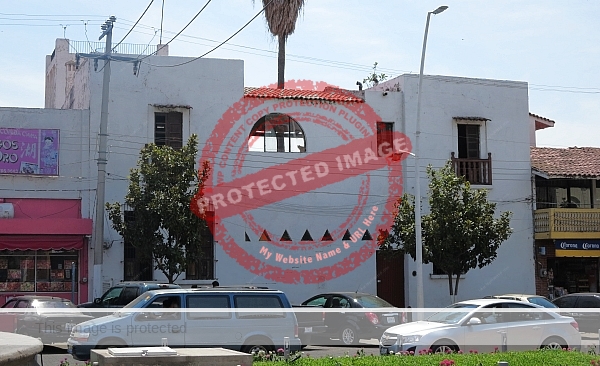The American poet Witter Bynner, who first visited Chapala in the company of D.H. Lawrence in 1923, purchased a house in the town in 1940. The original address of the house, close to the plaza on the main street down to the pier, was 411 Galeana, but the current name of the street is Francisco I. Madero.
Bynner’s home had previously belonged to the famed Mexican architect Luis Barragán (1902-1988). It had apparently belonged to the Barragán family since the end of the 19th century and had been transformed – by Luis Barragán himself, with the assistance of Juan Palomar y Arias – in 1931-32. (We will consider Barragán’s connections to Lake Chapala in a future post).
Bynner and his companion Robert “Bob” Hunt became regular visitors to Chapala for several decades. Their mutual friend, artist John Liggett Meigs, is quoted as saying that, “Bynner’s house was on the town’s plaza, a short distance from the lake. Hunt restored the home and, in 1943, added an extensive rooftop terrace, which had clear views of Lake Chapala and nearby mountains. It became Bynner and Hunt’s winter home.” (Mark S. Fuller, Never a Dull Moment: The Life of John Liggett Meigs, 2015). It is worth noting that, while the house was on the plaza when Bynner bought it, the center was remodeled (and the plaza moved) in the 1950s (see comment by Juan Palomar below) so that the house is now a short distance south of the plaza, though it is very close. In addition, as Palmora points out, the rooftop terrace was the work of Barragán and already existed when Bynner bought the house, though it was subsequently modified.
According to some sources, Bynner lent his home in Chapala to the then almost-unknown playwright Tennessee Williams in the summer of 1945. During his time at Lake Chapala, Williams wrote the first draft of A Street Car Named Desire.
At some point after Hunt’s death in 1964 and Bynner’s serious stroke in 1965, or upon Bynner’s death in 1968, the house in Chapala (and its contents) was purchased, jointly, by Meigs and another well-known artist Peter Hurd.
Meigs was particularly taken with the fact that the house had once belonged to Barragán, whose architectural work had been an inspiration for his own architectural designs. Mark Fuller writes that,
“the house had two floors, the rooftop terrace that Hunt had added, and a “tower” overlooking Lake Chapala. The other buildings on the block included a “wonderful cantina“, which became a supermarket; another two-story house next door, with a high wall between that house and Bynner’s courtyard; and a two-story hotel on the corner. However, after John [Meigs] and Hurd bought Bynner’s house, they discovered that the owners of the hotel had sold the airspace over the hotel, and, one time, when John arrived, he discovered a twenty foot by forty foot “Presidente Brandy” [sic] advertisement sign on top of the hotel, blocking his view of the lake. John said that that was when he and Hurd decided to sell the place. While he had use of it, though, he very much enjoyed it.”
In 1968, Hurd rented the house out to another artist Everett Gee Jackson. By a strange coincidence, Jackson had rented D.H. Lawrence‘s former residence in Chapala way back in 1923, immediately after the great English author left the town!
For a time, the Barragán-Bynner-Hurt/Meigs house was temporarily converted into warehouse space for a local supermarket, but is now once again a private residence.
Sources:
- Mark S. Fuller. 2015. Never a Dull Moment: The Life of John Liggett Meigs. Sunstone Press.
- Juan Palomar. 2019. “Chapala: primera de las cuatro casas que Luis Barragán hizo para sí mismo.” El Informador, 10 July 2019.
Sombrero Books welcomes comments, corrections or additional material related to any of the writers and artists featured in our series of mini-bios. Please use the comments feature at the bottom of individual posts, or email us.
Tony Burton’s books include “Lake Chapala: A Postcard History” (2022), “Foreign Footprints in Ajijic” (2022), “If Walls Could Talk: Chapala’s historic buildings and their former occupants” (2020), (available in translation as “Si Las Paredes Hablaran”), “Mexican Kaleidoscope” (2016), and “Lake Chapala Through the Ages” (2008).

Very interesting Tony. Will look it up for sure next time am in Chapala. I always love seeing examples of Barragan’s work, though in general am not that fond of modern or abstract. But he was special! Keep up the good work! Hugs, Phyllis
The original plaza was really in front of the house. It disappeared in the 50’s when all the row of “manzanas” from the edge of the town until the lake were barbariously demolished in order to have a “grand entrance” to Chapala. (Avenida Madero). This altered forever the scale and character of Chapala.
The rooftop terrace was the integral work of Barragán and Palomar. (With a pérgola”.)
I think that the only addition to their work is the strange tower-belvedere from the 40’s.
It is extremely interesting to know that T. Williams wrote there the first draft of one of the major works of XX century theater. A very small plaque should commemorate this fact, and another small plaque should also celebrate the great poet Witter Bynner…
Congratulations Tony. What a good work you do!!!
Thanks for the clarification about the site of the plaza (I knew it had been there at some point, but wasn’t sure when, so have amended that part of the post) and for the additional details. Your support and willingness to correct my errors is very much appreciated!
Interesting that all of those famous writers and artists were also in New Mexico (Santa Fe and Taos).
Definitely interesting, but perhaps not surprising given that artists and writers often move around quite a lot and tend to gravitate towards places where there are other artists and writers. (And, as another example, a Berkeley (California) – Lake Chapala flow is also noteworthy).